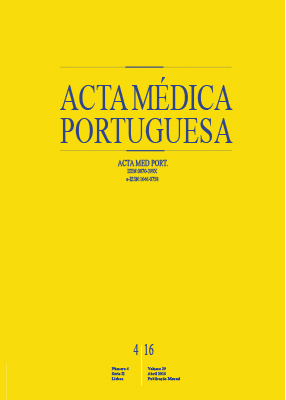Pattern of Retinal Nerve Fiber Layer Thickness Loss in Fetal Alcohol Syndrome: A Spectral-Domain Optical Coherence Tomography Analysis
DOI:
https://doi.org/10.20344/amp.6871Keywords:
Fetal Alcohol Spectrum Disorders, Optic Nerve Diseases, Nerve Fibers, Retina.Abstract
Introduction: Optic disc hypoplasia is a common feature in fetal alcohol syndrome. Thus, we aimed to evaluate the optic disc morphology changes and the peripapillary retinal nerve fiber layer thickness in these patients.
Material and Methods: We performed spectral-domain optical coherence tomography in a cohort of 11 patients (22 eyes) with fetal alcohol syndrome and in an age-matched control group. We evaluated optic nerve head parameters (optic disc area and diameter, rim area, cup/disc horizontal and vertical ratios) and peripapillary retinal nerve fiber layer thickness.
Results: Mean optic disc area, rim area and optic disc diameter were, respectively, in fetal alcohol syndrome patients and control subjects: 1.540 ± 0.268 and 1.748 ± 0.326 mm2; 1.205 ± 0.286 and 1.461 ± 0.314 mm2; 1.417 ± 0.124 and 1.501 ± 0.148 mm (p < 0.05). We found no significant differences between groups for cup/disc ratios. Mean retinal nerve fiber layer thickness was significantly lower in fetal alcohol syndrome patients (90.500 ± 9.344 µm) as compared to controls (111.000 ± 7.855 µm) (p < 0.0001). Analysis showed a significant decrease in retinal nerve fiber layer thickness for the superior, inferior and nasal quadrants (p < 0.005). The temporal quadrant showed no significant differences.
Discussion: Optic disc area, rim area and optic disc diameters were significantly reduced in fetal alcohol syndrome patients. Although mean peripapillary retinal nerve fiber layer thickness was decreased, the temporal quadrant was spared.
Conclusion: In addition to a smaller optic disc area/ diameter and rim area, we found a heterogeneous peripapillary retinal nerve fiber layer thickness loss in fetal alcohol syndrome patients with sparing of the temporal quadrant. Spectral-domain optical coherence tomography may be useful to determine the presence of fetal alcohol syndrome status.
Downloads
Downloads
Published
How to Cite
Issue
Section
License
All the articles published in the AMP are open access and comply with the requirements of funding agencies or academic institutions. The AMP is governed by the terms of the Creative Commons ‘Attribution – Non-Commercial Use - (CC-BY-NC)’ license, regarding the use by third parties.
It is the author’s responsibility to obtain approval for the reproduction of figures, tables, etc. from other publications.
Upon acceptance of an article for publication, the authors will be asked to complete the ICMJE “Copyright Liability and Copyright Sharing Statement “(http://www.actamedicaportuguesa.com/info/AMP-NormasPublicacao.pdf) and the “Declaration of Potential Conflicts of Interest” (http:// www.icmje.org/conflicts-of-interest). An e-mail will be sent to the corresponding author to acknowledge receipt of the manuscript.
After publication, the authors are authorised to make their articles available in repositories of their institutions of origin, as long as they always mention where they were published and according to the Creative Commons license.









